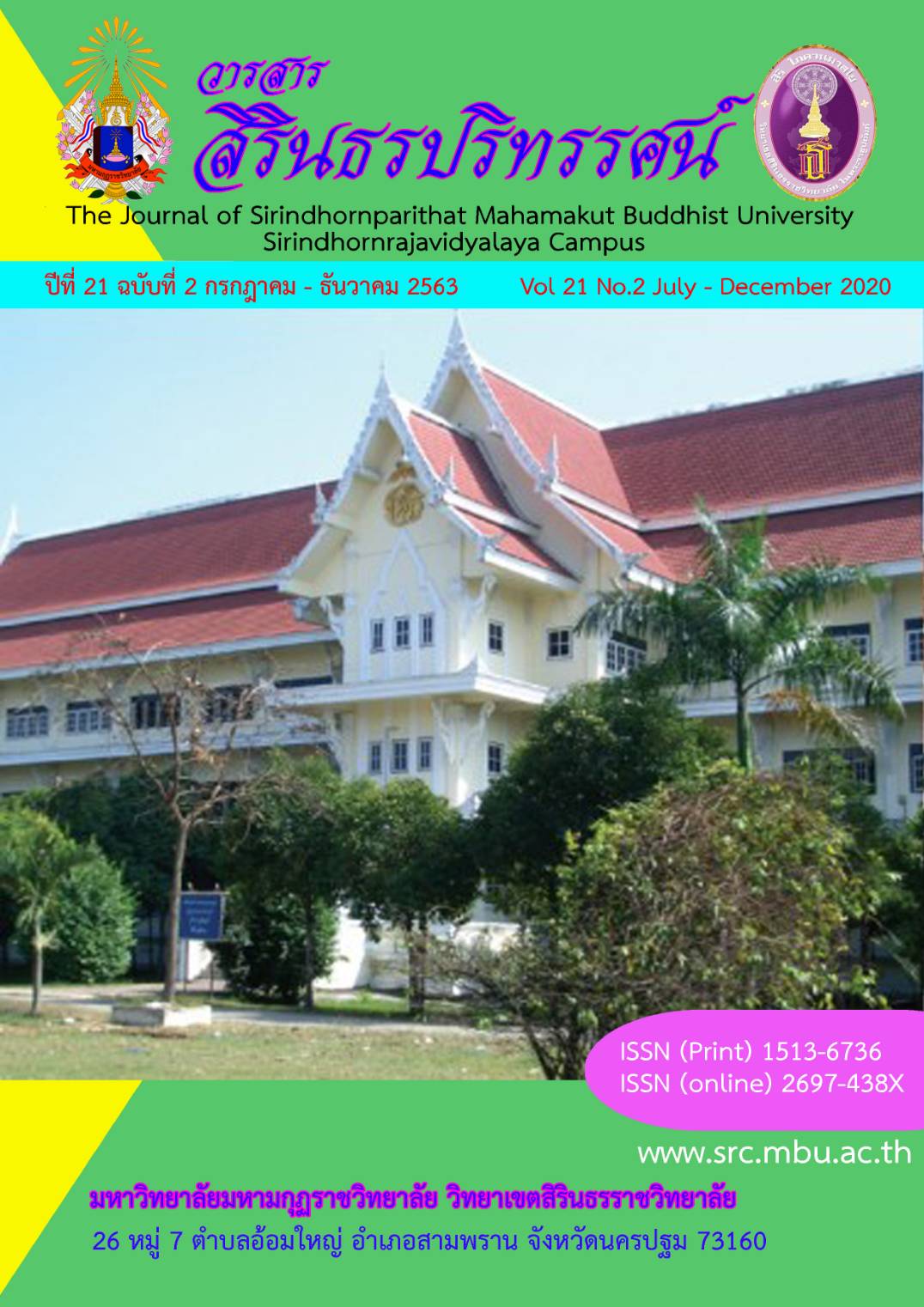Innovation in School Development for a Model School: Promoting Thinking Skills
Keywords:
innovation, school development, a model school, thinking skillsAbstract
The purposes of this research were to 1) explore factors of school development for a model school to promote students’ thinking skills; 2) examine the results of the confirmatory factor of school development for a model school to promote students’ thinking skills and; 3) determine the innovation in school development for a model school to promote students’ thinking skills. The sample consisted of the 234 administrators and teachers within the school network in the central region, which currently promotes students’ thinking skills. Krejcie & Morgan's formula was used to estimate the sample size. The stratified random sampling was given a particular sample: 24 school administrators and 210 teachers were selected. The informers for the questionnaire were randomized. The instruments in this research were structured interviews, open-ended questionnaires, and checklists. The statistical procedures used were descriptive statistics and Exploratory Factor Analysis.
The results can be concluded as follows:
- The factors of school development for a model school to promote students’ thinking skills composed of 8 elements namely: 1) school management strategy; 2) organizational structure of school management; 3) school management system; 4) school leadership; 5) teacher and staff development6) teaching and learning management and; 7) shared values in an organization.
- The agreement of experts on the results of the confirmatory factors of school development was appropriate, practical, and useful for a model school to promote students’ thinking skills.
- The school development for a model school to promote students’ thinking skills composed of 7 innovations and 41sub-innovations as follows: 1) school management strategy with six innovations; 2) organizational structure of school management with five innovations; 3) school management system with six innovations; 4) school leadership with five innovations; 5) teacher and staff 6) teaching and learning 7) shared values
References
บุญมา แพ่งศรีสาร (2561) คุณลักษณะผู้บริหารทางการศึกษาในยุคศตวรรษใหม่. วารสาร มจร นครน่านปริทรรศน์ปีที่ 2 ฉบับที่2 (กรกฎาคม - ธันวาคม 2561) 134-136
พรศักดิ์ สุจริตรักษ์ (2551) ตัวบ่งชี้การบริหารสถานศึกษาที่ส่งเสริมทักษะการคิดของนักเรียน. วิทยานิพนธ์ ปริญญาปรัชญาดุษฎีบัณฑิต สาขาวิชาการบริหารการศึกษา ภาควิชาการบริหาร การศึกษา มหาวิทยาลัยศิลปากร
พิมพ์ทอง มุสิกะปาน. (2558). การพัฒนากลยุทธ์การบริหารจัดการเพื่อพัฒนาทักษะการคิดของ นักเรียน ในโรงเรียน มัธยมศึกษา สำนักงานเขตพื้นที่การศึกษามัธยมศึกษา เขต 41. วิทยานิพนธ์ ปริญญาปรัชญาดุษฎีบัณฑิต สาขาวิชายุทธศาสตร์การบริหารและการพัฒนา มหาวิทยาลัยราชภัฏกำแพงเพชร สถาบันส่งเสริมการสอนวิทยาศาสตร์และเทคโนโลยี,(2562) ผลการประเมิน PISA 2018 ค้นหาเมื่อ เมษายน 7, 2563 จาก https://pisathailand.ipst.ac.th/news-12/
สำนักงานเลขาธิการสภาการศึกษา. (2560). แผนการศึกษาแห่งชาติ พ.ศ. 2560–2579). กรุงเทพฯ: พริกหวานกราฟฟิค จำกัด.
สุกัญญา แช่มช้อย. (2555). แนวคิดเชิงนวัตกรรมสำหรับการบริหารสถานศึกษาในศตวรรษที่21. วารสารศึกษาศาสตร์ มหาวิทยาลัยนเรศวร, 14(2), 117-128
อรชร ปราจันทร์ (2561, 53-54) การบริหารสถานศึกษาขั้นพื้นฐานเพื่อพัฒนาทักษะการคิดเชิงนวัตกรรมของครู วารสารการบริหารและนวัตกรรมการศึกษาVol.1 No.2 May-August 2018
อาจารี สุวัฒนพงษ์ (2558) กลยุทธ์การบริหารวิชาการเพื่อเสริมสร้างทักษะการคิดเชิงวิพากษ์ของนักเรียนโรงเรียนมัธยมศึกษา.วิทยานิพนธ์ปริญญาครุศาสตรดุษฎีบัณฑิต สาขาวิชาบริหาร การศึกษา ภาควิชานโยบายการจัดการและความเป็นผู้นำทางการศึกษา คณะครุศาสตร์ จุฬาลงกรณ์มหาวิทยาลัย
Adeyemi, Sunday B. (2012) Developing Critical Thinking Skills in Students: A Mandate for Higher Education in Nigeria. European Journal of Educational Research. Vol. 1, No. 2, 155-161
Bredson, Paul V. & Johansson, Olof. (2000) The School Principal’s Role in Teacher Professional Development.
Journal of In-Service Education, Volume 26, Number 2, Court, Barton (2020) Why Thinking Schools? Retrieved April 17, 2020, from http://www.bartoncourt.org/269/why-thinking-schools
Golding, Clinton (2005) Creating a thinking school. Retrieved April 15, 2020. from https://www.academia.edu/33328778/Creating_a_Thinking_School
Hyerle, David N., Alper, Larry (2014) Pathways to Thinking Schools. California: a SAGE company
Klaus Schwab. (2018). The global competitiveness report 2017-2018 Geneva: SRO-Kundig Press.
Klaus Schwab. (2019). The global competitiveness report 2019 Geneva: SRO-Kundig Press.
Krejcie, R. V., & Morgan, D. W. (1970). Determining sample size for research activities. Educational and Psychological Measurement, 30, 607-610.
Leen, Chiam Ching, Hong, Helen, Kwan Flora N. H., Ying,Tay Wan (2014) Critical Thinking in Singapore Schools. Office of Education Research, NIE/NTU, Singapore
Lipman., Matthew (2003) Thinking in Education. Cambridge, Cambridge University Press
Love, Sandra (2019) How Might Principals Model the 9 Traits of Critical Thinking?. Retrieved April 17, 2109, from https://www.mentoringminds.com/learn/blog/principals-model-the-9-traits-of-critical-thinking/
Mattila, Pasi, and Silander, Pasi (2015) How to Create the School of the Future: Oulu: University of Oulu
McGregor, Debra. (2007) Developing Thinking; Developing Learning: A Guide to Thinking Skills in Education. New York: Open University Press
McGuinness, Carol (1999). From Thinking Skills to Thinking Classrooms: A review and evaluation of approaches for developing pupils' thinking. Technical Report · January 1999 DOI: 10.13140/RG.2.1.4000.1129
Swartz, Robert, and McGuinness, Carol (2014) Developing and Assessing Thinking Skills. Project Final Report Part 1 February 2014 with all appendices
Tong, Goh C. (1997) Education for the Future: Thinking Schools. Speech at the opening of the 7th International Conference on thinking on Monday, 2 June 1997, at the SUNTEC City convention Center Ballroom.
Downloads
Published
Issue
Section
License
บทความที่ได้รับการตีพิมพ์เป็นลิขสิทธิ์ของ มหาวิทยาลัยมหามกุฏราชวิทยาลัย วิทยาเขตสิรินธรราชวิทยาลัย
ข้อความที่ปรากฏในบทความแต่ละเรื่องในวารสารวิชาการเล่มนี้เป็นความคิดเห็นส่วนตัวของผู้เขียนแต่ละท่านไม่เกี่ยวข้องกับหาวิทยาลัยมหามกุฏราชวิทยาลัย วิทยาเขตสิรินธรราชวิทยาลัย และคณาจารย์ท่านอื่นๆในมหาวิทยาลัยฯ แต่อย่างใด ความรับผิดชอบองค์ประกอบทั้งหมดของบทความแต่ละเรื่องเป็นของผู้เขียนแต่ละท่าน หากมีความผิดพลาดใดๆ ผู้เขียนแต่ละท่านจะรับผิดชอบบทความของตนเองแต่ผู้เดียว




